#OnePlus fingerprint sensor fix
Explore tagged Tumblr posts
Text
Replacing the Screen on the OnePlus 12 Pro
Replacing the Screen on the OnePlus 12 Pro – Complete Guide + 10 Must-Know Tips Introduction: Why Screen Replacement is Tricky The OnePlus 12 Pro is packed with premium hardware, including a stunning 120Hz LTPO AMOLED display with curved edges and high touch sensitivity. But its design — including a sealed glass back, in-display fingerprint sensor, and delicate flex cables — makes screen…
#AMOLED screen repair#DIY OnePlus repair#in-screen fingerprint sensor fix#mobile repair Sydney CBD#OEM OnePlus display#OnePlus 12 Pro cracked screen fix#OnePlus 12 Pro screen replacement#OnePlus 12 Pro troubleshooting#OnePlus back glass removal#OnePlus curved screen repair#OnePlus disassembly guide#OnePlus fingerprint sensor fix#OnePlus repair near me#OnePlus screen calibration#OnePlus screen damage fix#OnePlus screen replacement steps#professional phone repair Sydney#replace OnePlus display safely#replace OnePlus screen#sydney phone screen repair
0 notes
Text
Smartphone Buying Guide - Buy Best Mobile Phones

There are a couple of belongings you got to confine mind while buying the proper smartphone for yourself. You must identify what does one use your smartphone for. This guide takes you thru the entire process of choosing the simplest mobile .
Smartphones have snaked their way into almost every living moment of our technologically-fueled lives. More people are buying smartphones, and therefore the number of options is additionally increasing. Choosing a smartphone from such an awesome list of options might get confusing, so we made a guide that helps you choose the simplest smartphone for your needs.
You can check our extensive best smartphones buying guide for starters, but we recommend you to see out our guide the way to pick the proper smartphone in 2020.
WHAT to think about BEFORE BUYING A SMARTPHONE?
SMARTPHONE PERFORMANCE: PROCESSOR AND RAM
Your smartphone processor, also referred to as the chipset or the SoC, is that the component that's liable for almost everything working on your smartphone. it's essentially the brain of the system, and most of those processors also come equipped with AI capabilities that essentially make your smartphone as ‘smart’ it's today.
A capable processor not only allows your device to function seamlessly but is additionally capable of enhancing other factors. One example is image processing. Samsung phones, as an example, comes in two variants - one hosting the Snapdragon chipset (the latest one being Snapdragon 865+). In contrast, the opposite one employs Samsung’s in house Exynos processor (the latest being Exynos 990). Some reviewers have explicitly stated that there's a tangible difference in not just the processing power of the 2 variants, the Snapdragon being much snappier, but also the image-processing abilities.
So, once you choose your smartphone, it's integral to understand what processor you’re getting along side it since the performance directly correlates with it. Popular ones include Snapdragon, Apple A13 Bionic, Exynos 990, and Kirin 990. Apple processors are known for his or her raw computing power, and Snapdragon processors are the closest equivalent within the Android realm. you furthermore may have lower-powered processors for mid-range and budget devices like the Snapdragon 730 and 730G, Snapdragon 675, MediaTek Helio G90T and G85, and more, that are commonly found in lower-priced 2020 smartphones. If you’re on a budget and don’t mind sacrificing some power to save lots of money, consider buying phones with one among these processors since they drive down costs quite bit. Buying Guide
Coming to RAM, this refers to system memory that smartphones use to carry data that active applications are using. some of your smart- phone’s RAM is usually spent by the OS , to stay it run- ning. We’re not getting to get into the nitty-gritty of RAM usage during a phone since it involves explaining terms like kernel-space which can find yourself taking tons of room during this article. Having sufficient RAM can allow you to possess a bigger number of apps running within the background, which significantly affects your multitasking experience. However, some smartphones are breaking all barriers and installing a whopping 12-16 GB of RAM in their smartphones. That’s definitely overkill for smartphones, especially if you don’t plan on switching between 10-20 apps at an equivalent time. If you’re a light-weight smartphone user, someone who only uses their phone for calls, texts, What- sApp and lightweight browsing, you'll easily escape with 3-4 GB RAM. For power users, something round the ballpark of 6-8 GB is perfectly fine.
CHOICE OF OS
It boils right down to two options - Android or iOS. the selection is really more complicated than you imagine since both operating systems have a large list of pros and cons. If you’re someone who enjoys tinkering around together with your device and customising it to your heart’s content, you’re Team Android. If you wish an easy , powerful OS which gets constant software updates and is supported for a more extended period, you’re Team iOS. Nevertheless, Android is additionally almost as powerful but almost as simple, although the present Android version has become much simpler to use than the times of Gingerbread. Just know that iOS, as an OS, is sort of limiting, in some cases. as an example , you can't sideload apps from the web if they're not available on the App Store, the split-screen mode still isn’t a thing on iPhones (just iPads), you can't customise your home screen (although iOS 14 may include widgets), and you actually cannot use launchers to completely change the design of your phone. However, iOS comes with a plethora of benefits also , like iMessage, FaceTime, regular software updates, and therefore the biggest of all, minimal bloatware, and no adware! We’re watching you, Xiaomi!
PREFERED interface
You also need to confine mind that numerous smartphones accompany their own skin or UI (user interface) smacked on top of Android. OnePlus has OxygenOS, a clean skin that's quite on the brink of stock Android, Samsung comes with One UI 2, which has improved by leaps and bounds from its TouchWiz days, MIUI on Xiaomi phones, which is an ad-fest but is well-optimised, ColorOS on Oppo and Realme smartphones, that's heavily inspired by iOS.
Remember to undertake and knowledge the UI before buying the device to ascertain if it works for you.
A GOOD DISPLAY
Smartphone display sizes seem to be ever-increasing and are continually pushing the boundary of what we’d expect a smartphone display size to be. They’ve reached the ‘phablet’ realm with displays even reaching up to six .9-inches!
However, within the age where content is being consumed increasingly on our pocket devices (hard to call them that now), this might not be a nasty thing. we propose anything above 5.7 inches so you'll really immerse yourself into games and media. As far as display types go, you've got LCD and AMOLED displays. AMOLED displays have variants like OLED or Super AMOLED (in the case of Sam- sung) and have better contrast and darker blacks. They also assist in saving battery since they close up all the black pixels on the phone to display ‘true black’. Buying Guide
Next, you furthermore may have various resolutions like Full HD, Full HD+ Quad HD. While QHD does provide crisper images, the difference between FHD and QHD isn't too jarring, especially to the untrained eye. you ought to also check the screen protection on your device. Gorilla 5 and 6 are usually utilized in current-generation smartphones, and that they provide reasonable protection for your glass sandwiches. However, we still recommend a case strongly.
THE RIGHT AMOUNT OF STORAGE
The current standard is 64GB on lower-end models and 128GB to 512GB on flagships. With swift sharing apps and technologies, most folks import every single GB of knowledge from our previous phones to the new ones. So, adequate storage is important . We recommend that you simply don't go under 128GB since it'll offer you enough breathing space to stay your data also as download apps to your heart’s content. Also, keep an eye fixed out for phones with expandable memory storage. Buying Guide
BATTERY LIFE that matches YOUR DAILY REQUIREMENTS
The golden standard of battery life in flagship smartphones is 6+ hours of screen on time. Anything with higher capacities can mostly allow even heavy-users to power through. Flagship phones, also as some mid-range phones, also can reach 8-10 hours of screen on time, which is brilliant. The goal is to urge a phone which will a minimum of pull through one whole day of intensive usage. So, ensure to see battery tests online before purchasing a tool . Also, attempt to research if the phone you’re planning on buying features a decent power-saving mode. Buying Guide
CAMERA QUALITY THAT JUSTIFIES the worth
In 2020, multi-cameras are the norm and phones with only one rear camera are extremely rare now. you always get a primary lens which sports the very best MP count, a camera lens , and a wide-angle shooter. And then, you furthermore may have a couple of extras that some manufacturers add like the ToF (Time of Flight) sensor, macro lens, and colour filter lens. We, at the Digit Labs, are fans of the fisheye lens due to the magnitude of images you'll now combat phones. Capturing sprawling scenes isn't a drag anymore! The camera lens , when done well, can produce spectacular bokeh shots too. However, if this trend just isn’t for you and therefore the growing camera bumps enrage you, it might be best to shop for older phones with one primary lens or newer ones like the iPhone SE 2020. Also, don’t go MP hunting, higher megapixel-count doesn’t always mean better images since the sensor size is far more integral to producing good photos.
Smartphones have also been employing pixel-binning, which essentially turns four or more pixel into one big pixel, that adds clarity and detail to the image. Also, for now, attempt to stray faraway from the 108MP sensors since they’re pretty rough round the edges at the instant plagued with image fringing and autofocus issues.
MISCELLANEOUS THINGS to think about
Wireless charging
Gaming Mode
Fingerprint sensor vs Face Unlock
Bluetooth version
IP Rating
Dual sim
Reverse wireless charging
Stereo speakers
NFC
Dual-band Wi-Fi
WHAT to not CONSIDER?FOLDABLE DESIGNS
While the planning evolution is innovative and smart, it's just too early to be completely reliable. Our verdict? Hold off on buying foldable phones for a couple of years .Buying Guide
5G SMARTPHONES
In a country just like the US which is slowly but surely seeing widespread 5G integration (low band or mmWave), sure, choose 5G phones to futureproof. However, 5G integration in India remains a ways away, and therefore the proper rollout is years away. So, it makes no sense paying more to get a 5G phone.
#best smartphones buying guide#Buying Guide#Best Buying Guide#best smartphone overall#gsmarena top 10 smartphones 2020#best android phone 2020#flagship phone#compare flagship phones
1 note
·
View note
Text
OnePlus Suspends Buggy Oxygen OS 12 Update Rollout for the OnePlus 9 Series
Recently One Plus has suspended buggy OxygenOS12 (Android 12) for One Plus 9 and 9 Pro smartphones. According to early news updates related to the One Plus 9 series, One Plus has suspended the roll-out of the OxygenOS12 update for its 9 and 9 Pro /smartphones. The users experienced the One Plus OxygenOS12 earlier this week and found a few notable bugs, including bad animations, inconsistent performance, Wi-Fi speed issues, trouble with calls, and more.
One Plus 9 and 9 Pro users have reported major issues, and these issues are believed to be arising after switching from Oxygen OS to Color OS codebase. During this transition, various settings and features are not transitioning properly.
The statement from One Plus
One Plus said that they would release a bug-free update soon. They further said that they are aware of the issues arising from the OxygenOS12, and their software team is fixing the issues. They will suspend this software and roll out a new iteration as soon as possible.

One Plus 9 and 9 Pro specifications
One plus 9 and 9 Pro have a left-aligned punch hole cut-out slim bezels and an in-display fingerprint sensor. One Plus 9 has a 6.55-inch Full HD+ screen with a resolution of (1080 x 2400 pixels), and 9 Pro comes with an IP68 rating and a 6.7-inch QHD+ LTPO AMOLED display with a resolution of 1440 x 3216 pixels. Further, these One Plus smartphones offer a 120 Hz refresh rate and HDR10+ support.
These One Plus smartphones are powered with a Snapdragon 888 chipset that offers 12GB of RAM and up to 256 GB of storage. Further, these smartphones pack a 4500 mAh battery with 65 W fast-charging support. Handsets support Wi-Fi 6, Bluetooth 5.2, GPS, 5G, and Type-C port connectivity.
The users of One Plus are complaining about the loss of several customization features because Oxygen OS was known for having the most customizable Android features. The users are reporting different types of bugs in these smartphones, including slow Wi-Fi speed and poor animations.
A-One Plus community member has provided a simple guide to roll back to the previous Oxygen OS version to those who have already installed the update.
Conclusion
As per the report, One Plus users are reporting different types of issues in the One Plus 9 and 9 Pro smartphones. The notable concerns are slower Wi-Fi speed, bad animations, inconsistent performance, trouble with calls, and more. The issues are arising due to an OS transition made by One Plus. However, the One Plus software team has ensured the users with a bug-free update soon. According to a One Plus representative, they are suspending this buggy OxygenOS12 update and will roll out a new iteration soon. They have also released a simple guide to those who have already installed the update and how they can use the previous Oxygen OS version.
Visit: mcafee.com/activate
Source: https://xn--mcfecomactivat-wgb3kl.ijstartuk.com/oneplus-suspends-buggy-oxygen-os-12-update-rollout-for-the-oneplus-9-series/
0 notes
Text
How to Fix OnePlus Always on Display not Working
How to Fix OnePlus Always on Display not Working
OnePlus always on display OnePlus 6/6T comes with all premium features that like an in-display fingerprint sensor with a massive 6.41-inch (1080×2340) Gorilla Glass display. It’s come with a Qualcomm Snapdragon 845 octa-core (4×2.8GHz) processor paired with 6GB RAM and 128GB of internal storage. Also, it has a 3700mAh battery capacity. OnePlus has recently released its software update for…
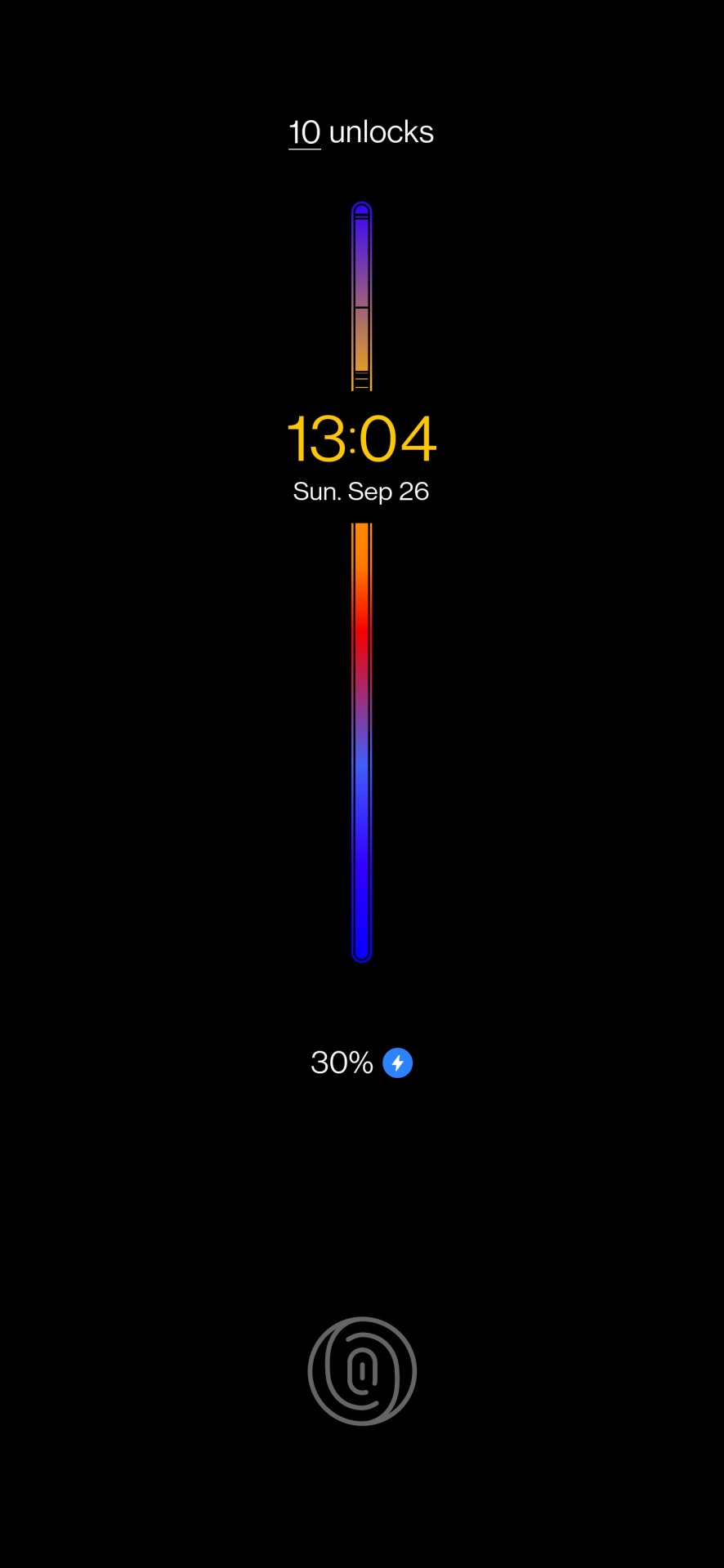
View On WordPress
0 notes
Text
OnePlus 8 Pro Review: Slickest Android of 2020
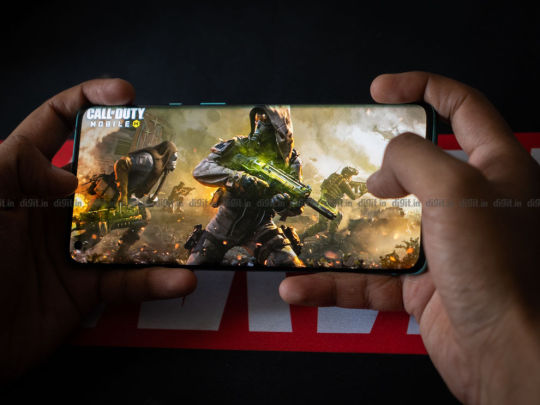
While there have been a handful of Snapdragon 865-powered smartphones, the OnePlus 8 Pro is easily the most anticipated one. It’s the company’s first true flagship and OnePlus has finally relented to offer things like wireless charging and an official IP rating, apart from the bells and whistles you’d expect from a top of the line premium flagship. After a week of using the phone as a daily driver, the phone is clearly good at what it does, but it’s not as flawless as OnePlus claims it to be, especially when you consider other options in this segment. Here’s our review of the OnePlus 8 Pro —
OnePlus 8 Pro performance
The OnePlus 8 Pro variant we received for review comes with 8GB LPDDR5 RAM and 128GB UFS 3.0 storage. Powering it all is the Snapdragon 865 SoC. Which basically guarantees the 5G part. Yet, despite being a key partner for Qualcomm, OnePlus has interestingly skipped on a lot of features that comes with the chipset by default. That includes features like being able to shoot HDR videos, portrait videos, unlimited slow-motion recording, HDR gaming, 8K videos and a lot more. Then again, OnePlus did include things like live captions, audio zoom when you’re zooming in on a video, a 10-bit HDR display and of course, the full suite of 5G support. If you are looking for a flagship that includes more of the Snapdragon 865 features, the Mi 10 and the Realme X50 Pro are good options to consider. Benchmark analysis The Qualcomm Snapdragon 865 flagship chipset is the primary driver of performance in this smartphone, combined with a 120Hz display and the OxygenOS 10 software. These three things come together to offer a fast, stable experience which is very much worth the premium you spend for this phone. Yet, it’s the same hardware that keeps the OnePlus 8 Pro from achieving the highest scores in benchmark apps —
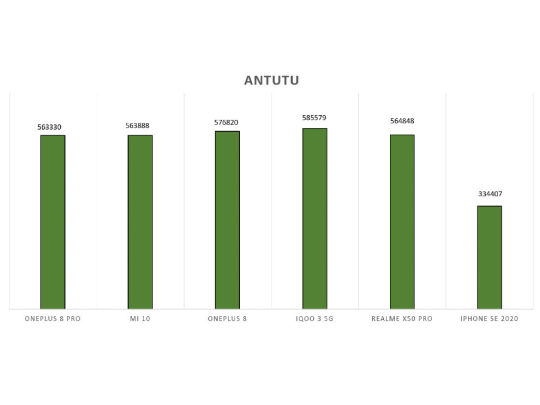
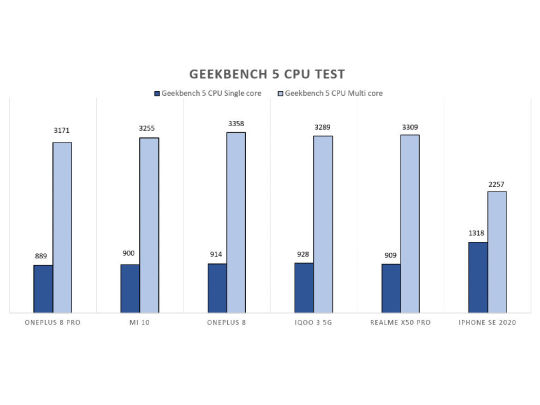

It’s surprising to see a Rs 34,999-priced Snapdragon 865-powered smartphone to outshine this year’s OnePlus flagship on benchmarks, but that’s just what we saw. And it’s not just the iQOO 3 5G we’re talking. Every single flagship Android phone we’ve tested this year has beaten the OnePlus 8 Pro on benchmark, although, the difference is perfectly within the margin of variance we expect in scores. Over the OnePlus 7 Pro last year, we saw around 15-18% boost in performance, which is good enough since there’s no app or game that’s specially built for this chipset, neither does it improve the experience in a noticeable way, as compared to the OnePlus 7T Pro that launched last year. Real world usage
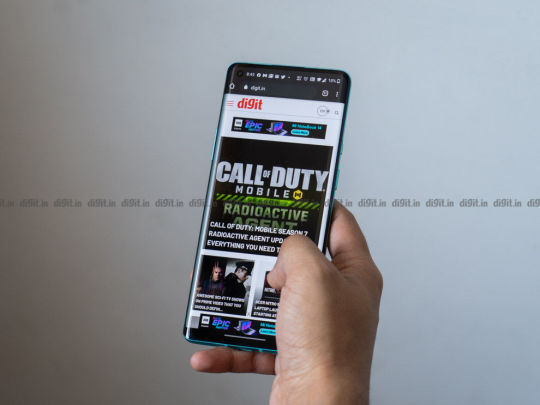
What does improve the experience is the 120Hz refresh rate on the phone. It feels far too smooth when compared against last year’s OnePlus 7 Pro, which again felt the smoothest back when it launched. The in-display fingerprint sensor is fast and accurate enough to unlock the phone in the first attempt, but more often I found the face unlock engaging even before my finger was scanned. A single scroll can browse past a lot more elements on the screen without looking stuttering and blurring. The haptic feedback is also strong and concentrated and typing on this phone is slightly better than the other Snapdragon 865-flagships. The UI also feels far more responsive, and thanks to the gesture navigation, switching between apps takes less than a second. However, there are chinks in this otherwise powerful armour. The OnePlus 8 Pro kept freezing for a few seconds every time my Instagram Stories feed would encounter a video, and sometimes even when I was scrolling down a recipe online. Unfreezing required a quick lock-unlock, but the issue persists even as I am writing the review. Nevertheless, we’ve reached out to OnePlus about it, and they have acknowledged it. So safe to say, a patch is incoming. The phone also heated up quite fast when used outdoors. I was out taking camera samples in a hot afternoon in Delhi and the phone heated to well over 50 degrees prompting it to issue a temperature warning. It didn’t shut down though, and quickly gave me a ‘temperature has been restored’ message right after I entered my building. In comparison, I have been taking samples from all other flagship Android phones this year out in the afternoon and this is really the first time I came across the phone heating just by using the camera out in the open. Can this be fixed with a software update? Unlikely. Gaming performance
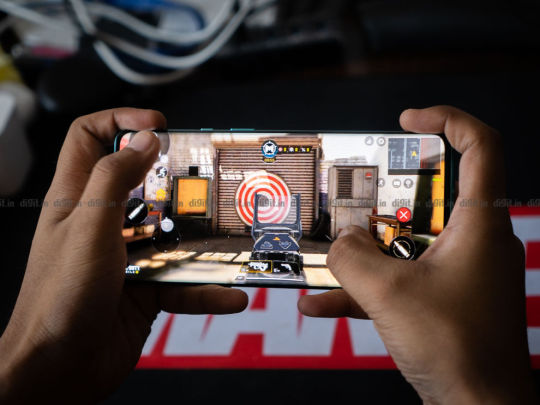
Thankfully, I never saw the overheating sign while gaming. The OnePlus 8 Pro responds really well to games, even when you are not using the Fnatic Mode that’s tuned to improve performance and keep away distractions. Yet, despite all the games we played, nothing really made the most of the high refresh rate display to run at 120FPS. But the nicely tuned display did deliver some fantastic visuals regardless. Except for Fortnite which ran at 90FPS but at low graphics, everything else was clocked to 60 FPS. Unfortunately, Fortnite didn’t allow us to clock performance using GameBench as it doesn’t support Android’s Developer Mode and USB Debugging.
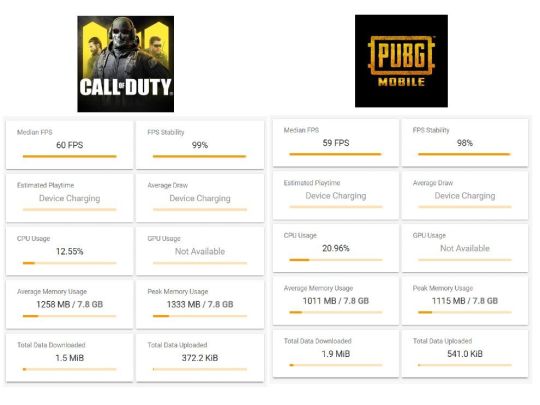

CPU frequency distribution while gaming on the OnePlus 8 Pro We did play our usual rounds of COD: Mobile and PUBG Mobile. The former clocked a stable 60 FPS with 99% stability while the latter delivered 59 FPS at 98% stability. The numbers are good enough for smooth gameplay. The touch response is good for a quick scope using a sniper on COD: Mobile’s multiplayer. The 2.86GHz prime core was regularly engaged while playing PUBG Mobile (despite which it couldn’t achieve 100% stability) while the CPU usage was around 30% at its peak. On COD: Mobile, the prime core hit 2.6GHz only twice and that too when my player died and had to respawn. There’s definitely room for improvement here, and OnePlus can do it with further tuning in a future update. Having said that, OnePlus devices have been popular enough among gamers for the company to seriously consider allowing more granular tuning of the CPU and GPU that we have seen on phones like the Asus ROG Phone II.
Software performance

I was using the Mi 10 before I started to review the OnePlus 8 Pro, and it’s really the OxygenOS 10 UI that sets the phone apart from all other Android smartphones. It’s just as slick and fast as stock Android, but comes with a lot more features. In front of skins like MIUI and RealmeUI, OxygenOS is far more refined and it just blends in with your life. There are no ads or bloatware that distracted me from the task at hand. And the UI elements, combined with the high refresh rate of the display feels far more responsive than anything else I’ve reviewed this year. The good thing is, OnePlus emulates the same experience on the OnePlus 8 and even the older OnePlus phones that are still receiving regular updates with new features every 1-2 months. I’ve also come to realise that using a OnePlus right when it launches will feel like a work in progress. The company has a penchant of using software builds riddled with bugs at launch, and there are a handful of them in the OxygenOS 10.5 version my unit came loaded with. The dark mode would invert colours of black and white pictures, especially on WhatsApp, while the live wallpaper app I was using (Metropolis. You guys should try it) had to reload the wallpaper after I would use an app or play a game for a long time. There’s also no always-on display. We’re at the cutting edge of AMOLED display technology here, but OnePlus still hasn’t figured out how to make an always-on display work. Remember, it used to be there until one random update took it away. And it never came back. The phone still shows incoming notifications discreetly on the screen, but you will have to pick it up or tap twice on the panel to surface it. But I did like the Google Assistant ambient mode the phone goes into when charging. It’s hella useful with all the information I need, right on the lockscreen.
OnePlus 8 Pro camera performance

The OnePlus 8 Pro features not one, but two 48MP cameras this time in a quad camera stack. There’s a primary 1/1.3” 48MP Sony IMX689 sensor that’s slightly larger than the 1/2” footprint of the previous generation. Then there’s another 1/2” 48MP IMX586 that’s used in the ultrawide lens which is what sets this phone apart from others in this segment. The quad camera stack also includes an 8MP telephoto lens with 3X hybrid zoom and a colour filter lens which was defunct in our review unit owing to the ongoing controversies around how it can see through plastic, and even clothes. What was OnePlus even thinking? During the course of using the phone, I was mostly staying indoors and the most of the outdoor samples you will see in this review are a result of quick grocery runs or taken while I was out walking my dog. But it still gave us a good idea as to how this flagship camera performs. We have uploaded these photos to our Flickr gallery in their original resolution. The samples below have been resized for the web. 48MP Primary camera with f/1.78 aperture and OIS Among all other OnePlus cameras we have tested over the years, this one gets the closest to beating the premium flagships in terms of the details and sharpness it produces when the light is optimum. Tricky situations don't perturb the camera all that much either and we managed a few good shots to show for it. The dynamic range is also quite good with photos balancing out the highlights and shadows to appear far more natural, than say the saturated output from the 108MP camera on the Mi 10. Samples below —
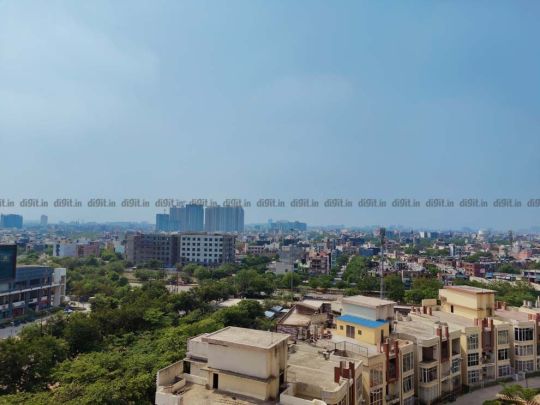

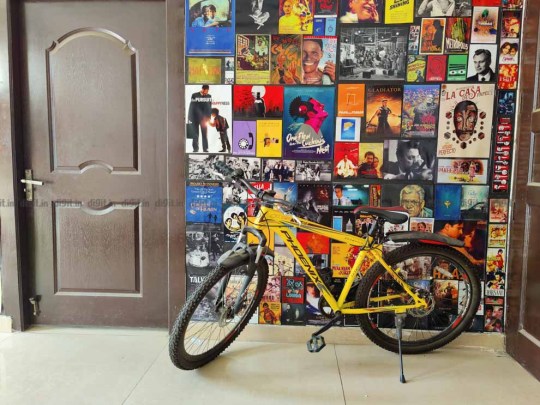
What did irk me was a tendency for the camera to highlight blue tones a lot more in the photos, and in some cases, noisy details, especially for indoor shots. The camera also has a smaller plane of focus which became apparent when I was trying to take photos of my culinary adventures, but it’s not the first time I’ve seen this issue. It’s present in almost all large-format high-res camera sensors, and there are reasons to believe that this is an inherent issue of the large sensor size and the lens arrangement inside the phone. Here’s an example —
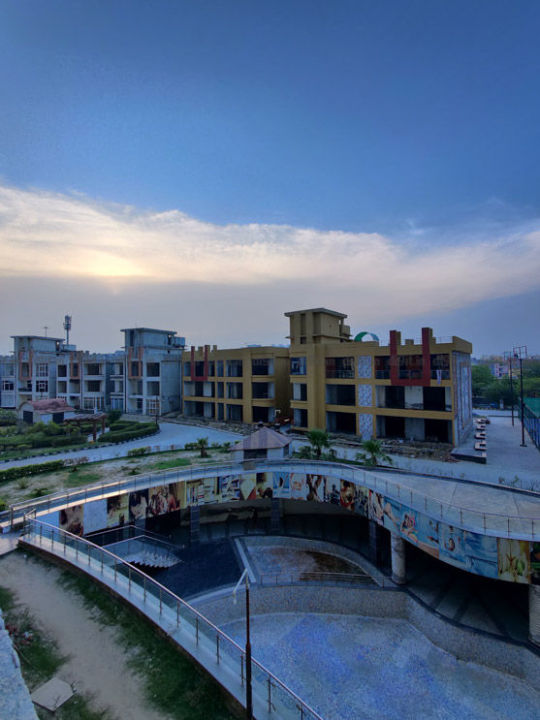
Excessive blue tones is an issue that needs to be addressed.

The area of focus is also quite small, causing issues in taking close-ups Videos from the primary 48MP camera aren’t all that good, especially when you compare against the regular OnePlus 8 and the Mi 10. It takes horribly long to focus on a subject up close and even when you do, it will drop the focus mid-way into the shoot and never recover until you start all over again. It’s a frustrating experience, and it happens at both 1080p and 4K resolution with 60 FPS output. The OIS is good enough for stability but the steady mode was what I used to take a stable video from an e-rickshaw I rode recently. 48MP Ultrawide camera with f/2.2 aperture and 119-degrees FOV. Throughout last year when these high-res sensors kept coming on smartphones cheap and expensive, I wondered what it would take to get the same amount of details from the ultrawide lens. The iPhone 11 series proved it doesn’t have to be treated as a step-child, but the OnePlus 8 Pro made it at par with the primary camera. As a result, you’ll get the best results from this ultrawide lens than from any other Android flagship right now. The 48 MP camera also delivers the best dynamic range in the wide-angle shots, among its peers and this is certainly a welcome addition. Samples below —

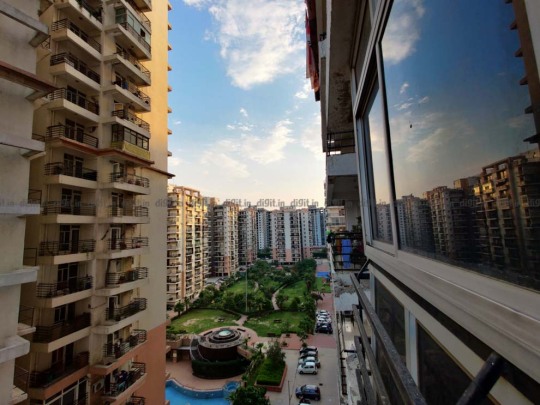
Surprisingly, the 48MP ultrawide lens is better at maintaining focus of a close-up object while taking videos than the primary camera. And if not for the smaller aperture which makes it unusable for videos when the light is low, this is what should have been the primary camera for videos. 8MP Telephoto lens with 3X hybrid zoom and 20X digital zoom The telephoto lens cannot keep up with the level of details you get from the other two cameras. OnePlus combines optical and digital zoom to let you zoom 3X, but details often look broken and full of noise. It lacks the sharpness you get from the other two lenses, and frankly, I used it much lesser than the primary and ultrawide lens. It’s also slightly slower in shutter response, but that’s more or less expected from a telephoto camera.
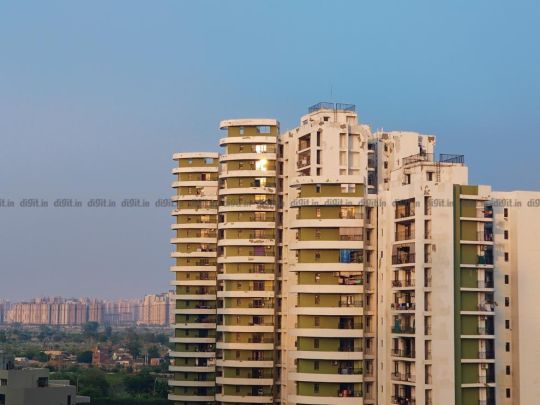

Night Mode OnePlus claims it is using new algorithms for the Nightscape mode for low light photos. But the quality of images you get mostly is the same we saw in the OnePlus 7T Pro with no dramatic improvement. What has improved is the speed at which the phone shoots a burst of photos at varied exposure, and I’d go out on a limb and say the processing is also a bit faster. But still not necessarily better.
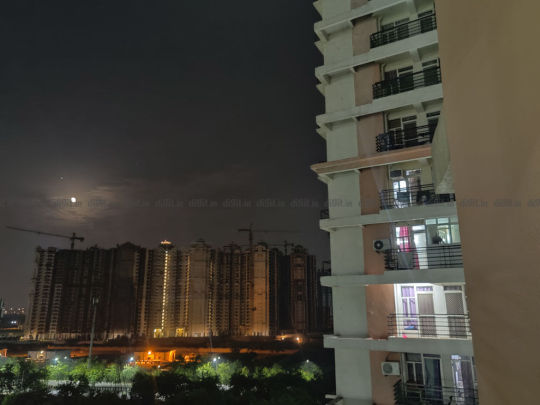
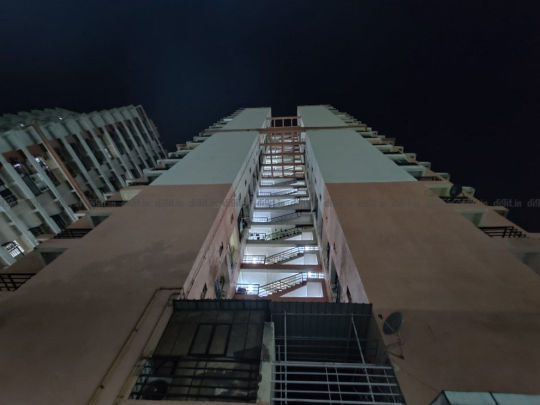
16MP Selfie Camera Being not much of a selfie camera user, I only take a few of them for the review. And it did come out good, with my face looking natural by default. There’s an option to smoothen the details as well. The selfie camera can also take lowlight shots using the Nightscape algorithm, and can shoot 4K videos at 60 FPS. You also get a slow-fie option.
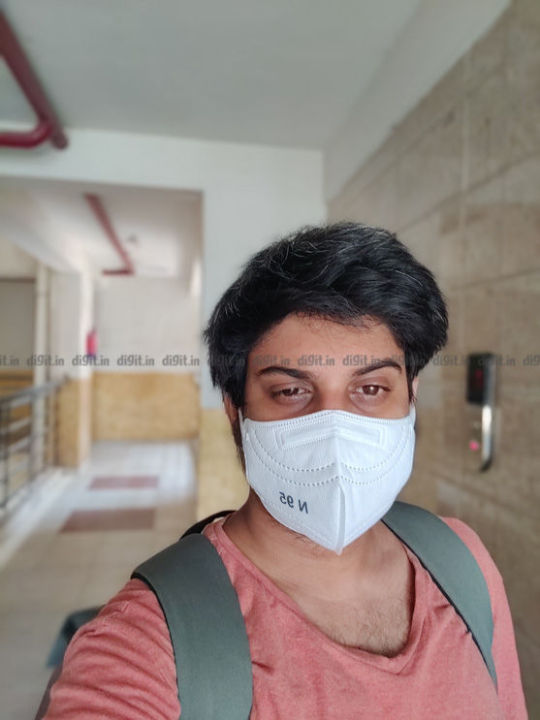
OnePlus 8 Pro Battery Life

I used the OnePlus 8 Pro for about a week as my primary device and the battery life is just about okay. If I am a little frugal in my usage, it can easily last a day. But on days where I’m on my phone all the time, the screen times range around 4-5 hours before it needs a quick refill, at the QHD+ 120Hz setting. It was 4 hours 30 minutes on the first day I set up the phone, downloading and installing all my apps, and restoring my WhatsApp data from the Mi 10 I was using previously. After that, with rounds of benchmarking, using the camera, gaming, back and forth texting and replying to emails, the phone lasted a good 6-7 hours. You can lower the display quality to extend the battery, which is what I’d suggest when you can’t be near a charging point throughout the day. Watching 30 minutes of HDR content on Netflix drains the battery by around 6 per cent while 15 minutes of COD: Mobile drained the battery by around 5 per cent.
OnePlus 8 Pro design and display

The OnePlus 8 Pro looks and feels like the premium flagship it claims to be. And OnePlus has finally included an official ingress rating for the phone. It is IP68 rated but it doesn’t cover water damage under warranty. However, it can easily survive a tumble in the sink or heavy rain. OnePlus has also included another much desired feature - Wireless charging. That too at an unheard of 30W speed, which requires the Warp 30 Wireless Charger sold separately. We didn’t get the chance to test it out yet. The variant we received was the Glacier Green colour, and on this, the company has given a matte finish which reminds me of the Pearl White variant of the OnePlus 6. It’s much slimmer and lighter than before now that the pop-up mechanism is replaced by a punch-hole camera on the display

The 6.78-inch QHD+ AMOLED display covers 90% of the body with very thin bezels on the top and bottom edge. On the side, the screen curves sharper than before, and while I admire the aesthetic, it actually hinders the display experience. There’s significant discolouration around the edges and that becomes apparent in the camera app, or when you’re watching a movie. The colours on the curved parts look different from the flat area. It took me a while to look past that. The panel also has a slightly warmer tinge owing to the DCI-P3 colour space it uses by default. Also the peak brightness only hit 786 lux in our light meter, which is far lower than what we saw on the regular OnePlus 8 and even on the Mi 10. We clocked upwards of 900 lux on them. The minimum brightness is still the same at 6 lux and I did feel my eyes strained while using it before bed.
OnePlus 8 Pro bottomline
The OnePlus 8 Pro ticks all the boxes for a premium flagship this time, and if not for an inconsistent camera performance, it would have been at par with the Samsung and Apple flagships. And that sort of breaks the deal for me because I need a camera that can take photos and videos with consistency for the content we produce on YouTube and Instagram. So if that’s not something you have to deal with, the OnePlus 8 Pro is the easier option to choose between the premium flagships available right now. There’s also the OnePlus 8 which works just as well sans the wireless charging, water resistance, 120Hz at QHD+ display, and a high-res wide-angle camera, which should be the primary reasons to buy this instead of the regular OnePlus 8. Source link Read the full article
#Android#OnePlus#OnePlus8Propriceinindia#OnePlus8Proreview#OnePlus8Prosale#OnePlus8Prospecs#Pro#Review#Slickest
0 notes
Text
Now regardless what brand we’re talking about: there’s always this sweet spot. The place where price and quality meet in the right proportions. When the Umidigi Z Pro was launched, it was far from this sweet spot. In fact, eventhough it had a fast processor and two decent camera sensors built in it was a dissaster!
And it was a dissaster happening at anything but a convenient time. His predecessor the UMi Z was just getting horrible press due to swollen batteries, an OTA software update that led the phone to brick completely and the always absent customer support of UMi/ Umidigi. In short: Not a good year for the UMi Company.
In fact one might come to the conclusion it was such a bad year that they even decided to rebrand. The name Umidigi appeared and with it the newest (or first so you will) Umidigi “flagship” the Umidigi Z Pro. Launched just a couple of months after the UMi Z, there was hardly any change to notice from the outside. Except the UMi Z made it look like it had two rear camera’s when in fact one of the two was the (tremendously failing) laser focus lens.The Z Pro came with two actual rear camera’s. In fact it sports the very decent Sony IMX258 sensors which have known to produce stunning results…
But sadly, in other brands phones! Because the Umidigi software buffs and engineers somehow didn’t manage to produce similar quality pictures and videos. However it might have been, considering the high quality camera sensors, the Mediatek Helio X27 (one of the fastest processors out there those days) and the 4000 mAh battery Umidigi dubbed the Z Pro their latest “flagship” and slapped a price-tag between 250 to 275 euro on the device. Since they were obviously in a hurry to rebrand, the Z Pro had to launch quickly, thus leaving an entire first generation customers to be beta-testers. Paying beta-testers even!
So much for the history of the Umidigi Z Pro. Now, like I said in the very beginning there is this sweet spot, when price and what you get for it are just in the right proportion. Well since Umidigi is launching a new “flagship” like every forthnight these days there has been a price drop. This means you can order the Umidigi Z Pro for anywhere between 129 and 150 euro now. But wait a minute? Why would I want to buy a bugprone phone that had the worst of press even if its half the original price now? If that’s the question you’re about to ask then read on. I will try to explain:
First let’s address some of the complaints about the original, first batch of Umidigi Z Pro phones. The battery life was terrible 3.5 to 4 hrs SoT, even though it was packing a 4000mAh battery. The camera had focus issues, and some customers were only able to use the monochrome camera if the wanted to shoot anything besides macro shots. It wasn’t able to view HD YouTube or Netflix feeds, which even last year, was rather sad. And the fingerprint scanner would respond randomly if at all. And ofcourse many cases of freezing. When we look at this severe list of problems we can conclude two things. The first obviously being the fact this phone should in NO WAY have been released already. And secondly: Given the quality of materials used (Sony Camera, Samsung RAM etc etc) and the mentioned list one can conclude the problem is in the software!
And this is the good news! Simply because most of those things can be fixed with software updates. And they did! Now let’s jump to 2018 and find that as soon as you start the phone up it offers you several OTA updates. Now truth be told it’s always a feeling like russian roulette to agree to an Umidigi update, but in the case of the Z Pro they were actually useful, and working flawlessly! So now, we have this light aluminium gun greyish body. A beautiful 2.5D screen with an oleophobic layer that’s running on Android 7.1, and that immediately impoved the battery life. So now it’s actually useable. Which is nice. They also improved the performance of the camera and some other bugs and glitches have been taken care of. So now, is it a perfect phone?
No, it’s not, but it’s a decent phone for a 140 euro price and it comes in this cool metal box, with this cool red charger cable. It’s got an iPhone 7 Plus/ OnePlus 5 vibe going on, and you can tell all your buddies your phone has a tencore chip. It might sound sarcastic and ofcourse I am, but truth is every thing looks slick and well build. The problem here was and remains the software. That being said with the updates installed, the Umidigi Z Pro is a pretty decent phone at it’s price. It runs on a Helio X27 decacore processor coupled with 4GB of RAM. Yet it’s impossible to get over 96K on the AnTuTu benchmark out of it.
Thanks to the update to Android Nougat the fingerprint scanner is flawless and fast and it’s able to hold the charge for 5 to 6 hours which again, is not what you would expect of a 4000mAh battery. But it’s almost twice as long as before the update, so definitely an improvement. Gaming is no problem on the Umidigi Z Pro and it can handle most of the games without any graphical problems. What I did notice though was the temperature of the phone is constantly very high. This hasn’t lead to any problems in the two weeks I used it. Maybe it can be related to the placement of the chipset.
Then, there is the camera. It certainly has improved after the update, but it still has some flaws too. Flaws that I personally would find inexcuseable in a 250-buck-flagship-phone, but are perfectly willing to deal with at a 130-140 euro price tag. The two main cons I consider to be the low light performance, that is … basically absent. Which might not sound like a big deal since a lot oof budget phones have trouble in low light. But here’s the thing: A) devices are getting better and anno 2018 even (some) low budget phones can shoot decent footage in the dark. And B) These phone don’t have a build-in camera option named “SUPER NIGHT MODE”. Correct me if I’m wrong, but that sounds promising. But the results are just migraine inducing, look at these examples:
These pics are supposed to be shot in “Super Night Mode” You judge….
Another thing on the camera of the Umidigi Z Pro is the dynamic range. At moments it’s perfectly on top of things. Yet shoot a second picture just seconds later and it’s a proper mess. Another equally mysterious phenomenon is the bokeh- or portrait mode. In one picture it seperates subject from the background just perfectly, the next shot is a mess again. Luckily it has an option to refocus after the shot has been taken. This can make up for some of the software’s mistakes, but sometimes even refocussing won’t help you out. Let me show you some “highlights” of dual camera missers:
Here you can see the camera struggling. Dynamic range is not the best
Some examples of bokeh software not knowing what to do
So, what you are saying it’s an okay phone for it’s price that’s well build, it just doesn’t have a good camera…right? Well… No. See and this is what did my head in reviewing this smartphone, it is able to shoot some incredible looking pictures. The monochrome mode is just stunning, and I was able to make some lovely shots with it. If the conditions are right it’s a great camera. Just make sure you’re always making more than one picture of whatever you want to save. It has a zoom-option that also is great to use. The shutter speed is absolutely fantastic and I was able to catch my kids jumping in mid-air on several occassions. So no complaints there.
Lovely Monochrome shot
Okay portait shot
And even a good one
But as soon as the lights go low, you might as well forget you’re even carrying a camera. Unless your using the flash you can forget anything will turn out other than grainy and blurry. Video camera, same problems. The colours, the sharpness..everything looks great, but there’s no continuous auto focus meaning you have to tap the screen every time you move. And it lacks any form of stabilisation, so better not breathe or footage will be shaky. If you dont move and have steady hands however, the camera shoots lovely pictures. So you see my problem here? For every pro there is a con and the other way around. And that goes for everything. No joke.
Take the speaker, volume is way above average, great in a noisy environment, unfortunately the sound quality is below mediocre. The fast charger is a fast charger, yet it charges other 4000mAh phones FASTER than the phone it came with: The Umidigi Z Pro. That being said, it charges fast enough to not be annoying, but you know, it’s all those little tiny things together that still make me not sure. One thing I am sure of is the price drop was a great move and much more fitting to the phone. Would I recommend it? That depends on who’s asking. Are you not a heavy use but1.) still want a phone that has a good build and is not too slow? 2.) looking for a good, modern looking phone in the iPhone/OnePlus-look The Umidigi Z Pro might be a great phone for you.
If however you are a heavy user and want more than a 50-60% succes rate when taking pictures, you might want to skip the Umidigi Z Pro altogether. After all heavy use and a relatively fast heating chip usually aren’t the best of friends in the long end. Just consider the fact you might also get a Meizu M6S or a Nubia M2 for the same price, those might be better alternatives. As always I conclude with some picture samples shot on the Umidigi Z Pro. Enjoy.
The Umidigi Z Pro: Failing Flagship to decent Budget Phone Now regardless what brand we're talking about: there's always this sweet spot. The place where price and quality meet in the right proportions.
1 note
·
View note
Text
Replacing the Screen on the OnePlus 12 Pro
Replacing the Screen on the OnePlus 12 Pro – Complete Guide + 10 Must-Know Tips Introduction: Why Screen Replacement is Tricky The OnePlus 12 Pro is packed with premium hardware, including a stunning 120Hz LTPO AMOLED display with curved edges and high touch sensitivity. But its design — including a sealed glass back, in-display fingerprint sensor, and delicate flex cables — makes screen…
#AMOLED screen repair#DIY OnePlus repair#in-screen fingerprint sensor fix#mobile repair Sydney CBD#OEM OnePlus display#OnePlus 12 Pro cracked screen fix#OnePlus 12 Pro screen replacement#OnePlus 12 Pro troubleshooting#OnePlus back glass removal#OnePlus curved screen repair#OnePlus disassembly guide#OnePlus fingerprint sensor fix#OnePlus repair near me#OnePlus screen calibration#OnePlus screen damage fix#OnePlus screen replacement steps#professional phone repair Sydney#replace OnePlus display safely#replace OnePlus screen#sydney phone screen repair
0 notes
Text
Google Pixel 5: Everything You Need to Know About
The much-awaited Google Pixel 5 is finally out. The Pixel 5 was recently launched on September 30, 2020, at Google’s Launch Night In event. It is one of Google’s top-end phones, and it’s the perfect option if you are looking for an affordable 5G phone offering great camera experience, having smaller-than-typical size with quality software and guaranteed updates. If you are thinking whether or not you should buy Google Pixel 5, then you have landed on just the right page. Here we will be discussing everything we know about the phone so that you can make an informed decision.
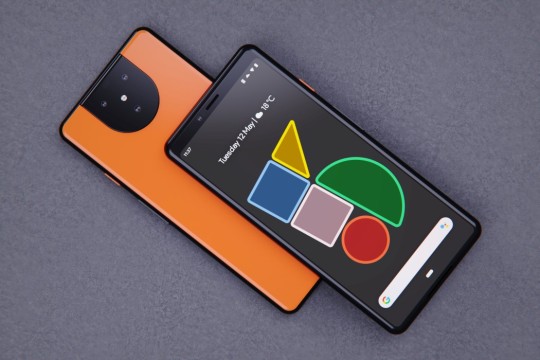
To start with, the Pixel 5 costs $699 in the US and is available in only one size, two colors, and one storage configuration. Its design and features are such that the Pixel 5 stands right next to LG Velvet, the Samsung Galaxy A71, the Galaxy S20 FE, the OnePlus 8, OnePlus Nord (outside the US), and some other upper mid-range to flagship 5G phones.
What Should You Expect From the Pixel 5 Camera?
The Pixel 5 has a 12MP IMX363 main camera, complemented by a new 16MP ultra-wide shooter, ditching the telephoto camera that came with Pixel 4a. This new camera will allow you to capture wider scenes, such as cityscapes, landscapes, and groups of people without having to take a few steps back.
Talking about the phone’s zoom capabilities, it is expected that the Pixel 5 Zoom quality will be somewhat like Pixel 3. Super Resolution Zoom without a telephoto lens should capture distinct images at least till 2x or 3x zoom shots. Also, Google is bringing a serious upgrade in terms of exposure bracketing on Pixel 5 that should pull out more clear photos. Google’s fantastic Night Sight and Portrait Light is also coming to portrait mode. This will allow you to add effect to your portrait photos, which turn out to be with dark subjects. Google has also tweaked video quality in Pixel 5. This fantastic phone is coming with three new stabilization modes: locked, active, and cinematic pan.
How Is the Pixel 5 Battery Life?
The Pixel 5 battery is over 1,000mAh bigger than the Pixel 4’s 2,800mAh pack, however, its 5G connectivity might result in higher battery consumption. Also, Pixel 5 is going to have an extreme battery saver mode that will allow you to pause everything except the apps you like to use. According to Google, this feature will get you up to 48 hours of additional battery life.
Is the Pixel 5 Fast Enough?
The Pixel 5’s Snapdragon 765G processor makes it weaker than the Pixel 4. Not to mention the huge gap between the Pixel 4’s and Pixel 5’s graphical performance. Anyways, the gap between the CPU performance delivered by the Snapdragon 765G and the Snapdragon 855 is pretty small, making it ideal for single-cores performance. Long story short, Pixel 5’s chipset can deliver great performance in most of the general games. However, you shouldn’t consider Pixel 5 if you play advanced games.
Google Pixel 5 Specifications
Display:
6-inch OLED
2,340 x 1,080 resolution
432ppi
90Hz refresh rate
19.5:9 aspect ratio
>1,000,000:1 contrast ratio
Processor:
Qualcomm Snapdragon 765G
2x Cortex-A76
6x Cortex-A55
Titan M Security Module
GPU: Adreno 620
RAM: 8GBnLPDDR4x
Storage:
128GB
No microSD slot
Cameras:
Rear
Main: 12.2MP, f/1.7 aperture, 1.4µm pixels, optical + electronic image stabilization
Secondary: 16MP, f/2.2 aperture, 1 micron pixel, ultra-wide (107-degree FoV)
Front: 8MP sensor, f/2.0 aperture, 1.12µm pixels, fixed focus, 83-degree FoV
Headphone jack: No
Battery:
4,080mAh
18W charging
12W wireless charging
Reverse wireless charging
IP rating: IP68
Sensors:
Proximity / ambient light sensor
Accelerometer
Gyrometer
Magnetometer
Pixel Imprint fingerprint sensor
Barometer
Spectral and flicker sensor
Software: Android 11
Dimensions and weight:
144.7 x 70.4 x 8mm
151g
Colors: Just Black, Sorta Sage
Should You Buy Google Pixel 5?
For the buyers in the US where brands like Realme and Xiaomi are not available, Google Pixel 5 priced at $699 looks like a good phone. Talking in general, if you are looking for an affordable 5G phone with flagship-style features, then Pixel 5 is currently your best bet. Those looking for the most reliable phone should keep in mind that Google’s Pixel series have suffered from hardware issues in the past. Coming to the specifications sheet, Pixel 5 looks far better than Pixel 4’s small battery and lack of a triple rear camera compared to the rival phones.
This was all we have so far on Google Pixel 5. Hope this helps you in deciding whether you want to buy the phone or not.
Source : https://dgrabber.com/google-pixel-5-everything-you-need-to-know-about/
0 notes
Video
youtube
http://digitaltechnologynews.com/ Samsung Galaxy A8+ Plus (2018) vs OnePlus 5 Smartphones Samsung Galaxy A8+ Plus (2018) The all new A8 (2018) and A8+ Plus comes with the infinity display treatment, which means no physical hardware buttons up front and rear-positioned fingerprint scanner. Samsung Galaxy A8+ Plus (2018) specs So the new Galaxy A8 features Full HD+ displays with a resolution of 1080 by 2220 pixels weighing at 5.6-inches. The hardware inside is an Exynos SOC joined by 4GB of RAM.Samsung Galaxy A8+ Plus (2018) camera unboxing Samsung Galaxy A8+ Plus (2018) camera If you expected good 12MP cameras with large 1.4micron pixels like on the flagship line, you are in for a disappointment. The Galaxy A8 and A8+ are equipped with a single 16MP camera with f/1.7 lens on the back, and dual 16MP fixed focus (f/1.9) + 8MP (f/1.9) selfie snapper at the front. We don't expect wonders from these kits, as last year's A7 also had 16MP cameras with small pixel sensors and pretty mediocre snappers, but Samsung may pleasantly surprise us, as there is much wider aperture and phase-detection autofocus on the rear now, and a dual camera at the front for some pleasant portrait selfie photography.Samsung Galaxy A8+ Plus camera review Samsung Galaxy A8+ Plus (2018) price How much for the Galaxy A8 and A8+? They will be available in January in black, orchid grey, gold and blue for about EUR499 and EUR599, respectively, and the fact that the pricing is given in European currency should hint at you that we might never see these two released officially on a US carrier. Samsung Galaxy A8+ Plus (2018) features So, what are these two waterproof, IP68-certified beauties powered by? An octa-core Exynos chipset with 2.2 GHz maximums, coupled with 4GB RAM (the A8+ has a 6GB RAM version with 64 GB storage as well). Internal memory strikes above the midrange crowd with up to 64GB models, while the battery packs are 3000mAh and 3500mAh, respectively. Samsung Galaxy A8+ Plus 2018 model Samsung's newest midrangers are made entirely of glass, and sport the Infinity Display design of their flagship siblings, albeit in a more unrefined form, with thicker top and bottom bezels, and no flexible, side-sloping displays. The 5.6" and 6" 1080x2220 pixels displays still keep Samsung's weird signature 18.5:9 aspect ratio, though. Samsung itself acknowledges that the A8 and A8+ fit "the stunning ergonomic design that draws on Samsung’s flagship design heritage and experience" in the presser. OnePlus 5 The all new OnePlus 5 - the company's 2017-edition "flagship killer" - is expected to follow in the footsteps of previous OnePlus high-ends. Rumor has it that the phone will stick to the concept of offering top-notch specs, appealing design, and lightweight software, all while costing considerably less than other smartphone makers' flagships. Rumored features include a 5.5-inch display, metal build, and a Snapdragon 835 chip, as well as plentiful amounts of memory and battery capacity. But the most notable upgrade over last year's OnePlus 3T could be the move to a dual camera at the back. There's no word on what advantages this dual camera could bring, but we should know soon enough. The OnePlus 5 is expected to lauch in the very near future.
2 notes
·
View notes
Text
Week 24 in review: PlayStation 5 hardware shown, Mi Band 5 is here
Welcome to your week’s recap. Amazingly the most popular device of the week wasn’t a phone but rather the Sony PlayStation 5. The PlayStation 5 will come in a sleek new white and black body meant to stand upright. It will be sold in a version with an optical 4K Blue-ray drive and a version without one, called PlayStation 5 Digital Edition.
We also saw a listing for the PS 5 on Amazon, citing a price tag of £599.99 ($760/670). The next-gen console is due sometime in the second half of 2021.
Moving on to OnePlus and its first truly-affordable phone in years. The OnePlus Z’ specs and Indian price leaked – it will have a 6.55-inch SuperAMOLED with 90Hz refresh rate, a Snapdragon 765G with 6GB of RAM, 128GB of storage, a 64MP camera plus a 16MP ultrawide, 4,300mAh battery and 30W charging. Pricing is a rumored INR 24,990 (~$330).
The Xiaomi Mi Band 5, the latest member of the best-selling fitness tracker family on the planet, was unveiled. It brings a bigger 1.1-inch OLED screen (the Mi Band 4 has a 0.95-inch screen), a new magnetic charger that finally doesn’t require you to take the tracker out of the band, 11 new tracking modes, a more accurate heart-rate sensor and the same great starting price – $26 for the non-NFC, $30 for the NFC model in China.
Motorola unveiled the One Fusion+. It’s a Snapradon 730-powered smartphone with a 6.5-inch IPS LCD of 1080p+ resolution. The 16MP selfie camera is tucked inside a motorized pop-up mechanism. On the rear there’s a fingerprint scanner and four cameras – a 64MP main, 8MP ultrawide, 5MP macro units and a 2MP depth sensor. The One Fusion+ has a 3.5mm headphone jack but no NFC and a 5,000mAh battery that charges at 15W. The Motorola One Fusion+ will launch in Europe later this month and it will cost 300.
The other major release this week was the Xiaomi Redmi 9 with a Helio G80 chipset, 6.53-inch IPS LCD, 13MP main camera with a 8MP ultrawide, 5MP macro and 2MP depth sensor. The entry-level 3/32GB version costs 149, there’s also a 4/64GB for 179.
Those were the highlights of last week, the full list of hottest stories is below. See you in a week!

Sony will unveil PlayStation 5 games later today through an online event.

90Hz display and 30W fast charging are on the menu.

Also showcased a ton of new games coming next year.
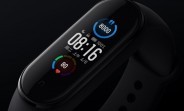
Great value fitness tracker as always.

It’s similar to the One Hyper, but with a faster chipset. The 6.5″ 1080p+ display now supports HDR10.
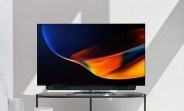
Both versions get Bluetooth certification, two separate remote controls get certified as well.
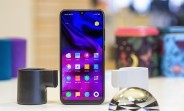
Only the Chinese units are receiving the firmware right now.
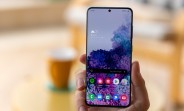
It remains to be seen how Samsung will handle ad placement in its upcoming One UI update.
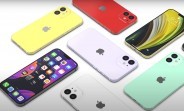
The lineup reportedly includes four models.
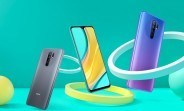
The phone brings four cameras and a Helio G80 to the aggressively affordable market.
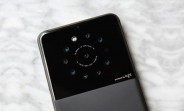
The Horizon Edition takes things up a notch.
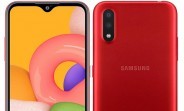
It’s unclear what this phone will be named, but it should be even cheaper than the A01.
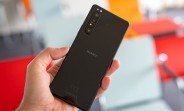
A new bundle with a cover case is available.

As expected it looks similar to the outgoing Mi Band 4 but will pack plenty of new features.

The router also features smart home integration. Pre-orders in China start tomorrow, the price is $35.

The technology fixes brightness, color gamut, and viewing angle differences, brings algorithm for pixel arrangement on a new screen material.

This means that HMD will have to look elsewhere for the camera on the perpetually-delayed Nokia 9.3 PureView.
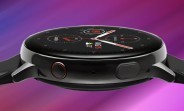
The pages bring no specs with them.
Source link
قالب وردپرس
from World Wide News https://ift.tt/3e5n37A
0 notes
Photo
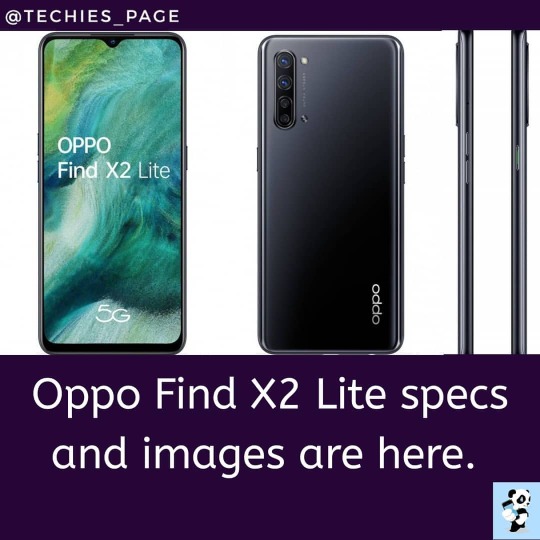
Welcome to our most comprehensive look yet at the Oppo Find X2 Lite, complete with images and specs. Unsurprisingly, the Oppo Find X2 Lite matches the already-announced Oppo Reno3 Youth spec for spec, and also looks identical. What that means is a 6.4-inch 1080x2400px AMOLED screen up front, complete with a teardrop notch and an under-display optical fingerprint scanner. The chipset is a 7nm Snapdragon 765G, which includes an octa-core processor and a 5G X52 modem. RAM is fixed at 8GB while storage is a non-expandable 128GB. The cameras are as follows - a 48MP f/1.7 1/2.0-inch main snapper, 8MP f/2.2 ultrawide unit, 2MP macro cam and 2MP depth sensor. On the front there's a 32MP selfie camera. The battery is a 4,025mAh unit capable of 30W wired charging and no wireless charging. The software is Color OS 7.0 under Android 10. There's also the rare inclusion of a headphone jack. We can also expect the exact same specs on the OnePlus 8 Lite, whenever that arrives, only instead of Color OS 7.0, there'll be OxygenOS 10.0. The Oppo Find X2 Lite will come to Europe in Black and White with an expected price of €500. . . . . #oppo #oppofindx2lite #findx2lite #opporeno3youth #reno3youth #amoled #snapdragon765g #8gbram #128gb #48mp #8mp #2mp #32mp #fastcharging #coloros #coloros7 #android10 #headphonejack #oneplus8pro #oneplus8lite #europe #usa #uk #unitedstatesofamerica #techies_page #techies #tech #technology #unitedkingdom #france https://www.instagram.com/p/B-rSaVpgucy/?igshid=d1kcpzp1ejpr
#oppo#oppofindx2lite#findx2lite#opporeno3youth#reno3youth#amoled#snapdragon765g#8gbram#128gb#48mp#8mp#2mp#32mp#fastcharging#coloros#coloros7#android10#headphonejack#oneplus8pro#oneplus8lite#europe#usa#uk#unitedstatesofamerica#techies_page#techies#tech#technology#unitedkingdom#france
0 notes
Text
Samsung Galaxy Note 10 Lite Starts Receiving New Update With Improved Camera and Battery Performance in India
New Post has been published on https://magzoso.com/tech/samsung-galaxy-note-10-lite-starts-receiving-new-update-with-improved-camera-and-battery-performance-in-india/
Samsung Galaxy Note 10 Lite Starts Receiving New Update With Improved Camera and Battery Performance in India


Samsung Galaxy Note 10 Lite has received a new software update (build number N770FXXU2ATB6). The Galaxy Note 10 Lite software update is similar to a recent update for the Galaxy S10 Lite that was released earlier this week, as it brings improvements to the camera performance and better fingerprint recognition, along with the February 2020 security patch. Gadgets 360 can confirm the rollout of the new software update on Galaxy Note 10 Lite.
As per the official changelog shared by Samsung, in addition to camera and fingerprint sensor improvements, the new update brings battery charging algorithm and stability improvements, touch panel performance enhancements, and improvements in the overall stability of functions. Additionally, the February Android Security Patch has also been added to improve the security of the phone.
SamMobile was first to spot the Galaxy Note 10 Lite update. The new update, according to SamMobile, is only available in India and Russia right now, but it should soon make its way to other markets as well.
Like always, the software update is available to Galaxy Note 10 Lite users over-the-air and it will automatically reach all units. You can head over to Settings > About phone > Software update to manually look for it. The latest update is 295.18MB in size.
A similar update was announced on the Samsung S10 Lite earlier this week, which brought the February 2020 security patch to the device and added new camera features like 4K recording at 60fps, steady mode at 4K resolution and improvements to picture quality, among other general stability and bug fixes
Samsung had launched the Galaxy Note 10 Lite in India in late January, along with the Galaxy S10 Lite, with an aim to make its range of premium smartphones more affordable, and to penetrate the sub-Rs.40,000 segment which has been dominated by OnePlus for quite some time now.
Samsung Galaxy Note 10 Lite specifications Samsung Galaxy Note 10 Lite comes with a 6.7-inch full HD+ Infinity-O Super AMOLED display with a 394ppi pixel density, a screen larger than the Samsung Galaxy Note 10, which houses a 6.3-inch full-HD+ Infinity-O AMOLED display. The phone is powered by Samsung’s own Exynos 9810 processor, paired with up to 8GB of RAM and 128GB of internal storage.
The phone also comes with a triple-camera setup on the back, housed in the rectangular camera module, with a 12-megapixel main camera with an f/1.7 lens and OIS support, assisted by a 12-megapixel wide-angle camera with an f/2.2 aperture and 123-degree field of view, and a 12-megapixel telephoto lens with an f/2.4 aperture, 2x optical zoom, and OIS for stabilisation. The front duties are handled by a 32-megapixel selfie snapper with an f/2.2 aperture.
0 notes
Photo
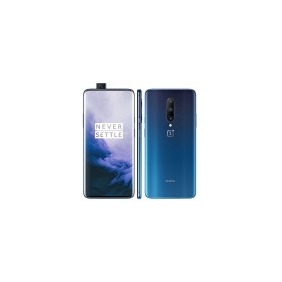
OnePlus 7 Pro Smartphone
Welcome to saleholy.com, Buy Cheap China Mobile smartphones and Samsung or iphone mobiles Best Upcoming smartphones with all specification.You can see it in very effective price.Visit our site more info. http://www.saleholy.com
Basic Information Model OnePlus 7 Pro(8GB+256GB) Network 2G: GSM: B1(2100)/B2(1900)/B5(850)/B8(900) CDMA: BC0(800)/BC1(1900) 3G: WCDMA: B1(2100)/B2(1900)/B4(1700/2100)/B5(850)/B8(900)/B9(1700)/B19(850) TD-SCDMA: B34(2000)/B39(1900) 4G: FDD-TLE: B1(2100)/B2(1900)/B3(1800)/B4(1700/2100)/B5(850)/B7(2600)/B8(900)/B12(700)/B13(700) /B17(700)/B18(800)/B19(800)/B20(800)/B25(1900+)/B26(850)/B28(700)/B29(700)/B66(1700/2100) TDD-TLE: B34(2100)/B38(2600)/B39(1900)/B40(2300)/B41(2500) SIM Card Dual SIM Card Dual Standby (Nano SIM) Style Bar Color Mirror Gray/Nebula Blue Back Material 3D Corning Gorilla Glass Highlights 6.67 inch QHD+ 3120*1440 Pixels Conring Gorilla Glass 6 8GB RAM 256GB ROM Snapdragon 855 Octa Core 4000mAh Battery 48MP + 16MP Cameras Popup Selfie Camera System OS OxygenOS based on Android 9 CPU Qualcomm Snapdragon 855 (Octa-core, 7nm, up to 2.84 GHz), with Qualcomm AI Engine GPU Adreno 640 RAM 8GB LPDDR4X ROM 256GB UFS 3.0 2-LANE Card Extend NO Screen Display Size 6.67 Inch 2K+ HDR10+ Type Fluid AMOLED Resolution 1440 x 3120 pixels QHD+ Protection 3D Corning Gorilla Glass 6 PPI 516ppi Aspect Ratio 19.5:9 Brightness 800nit Panel Technology Multi-touch Other Features Support sRGB, Display P3 Video Enhancer Reading Mode Night Mode Support Format Audio File Format MP3, AAC, AAC+, WMA, AMR-NB, AMR-WB, WAV, FLAC, APE, OGG, MID, M4A, IMY, AC3, EAC3, EAC3-JOC, AC4 Audio Recording WAV, AAC, AMR Audio Dual stereo speakers Noise cancellation support Dolby Atmos Video File Format MKV, MOV, MP4, H.265(HEVC), AVI, WMV, TS, 3GP, FLV, WEBM Video Recording MP4 Image File Format JPEG, PNG, BMP, GIF Image Output JPEG, PNG Loudspeaker Yes Earphone Port Type-C Data Transfer & Connectivity Data transfer USB/bluetooth Mobile internet WAP/WiFi Features Rear Camera Main:48MP IMX586 Pixel Size: 0.8 µm/48M; 1.6 µm (4 in 1)/12M Lens Quantity: 7P OIS, EIS Aperture: f/1.6 Telephoto Lens: 8MP Pixel Size: 1.0µm OIS Aperture: f/2.4 Ultra Wide Angle Lens: 16MP Aperture: f/2.2 Field of View: 117° Autofocus: Multi Autofocus (PDAF+LAF+CAF) Features: UltraShot, Nightscape, Studio Lighting, Portrait, Pro Mode, Panorama, HDR, AI Scene Detection, RAW Image Video: 4K video at 30/60 fps 1080P video at 30/60 fps Super Slow Motion: 1080p video at 240 fps, 720p video at 480 fps Time-Lapse Video Editor Front Camera 16MP f/2.0 IMX47 Pixel Size: 1.0 µm EIS Autofocus: Fixed Focus Features: Face Unlock, HDR, Screen Flash, Face Retouching Video: 1080P video at 30fps Time-Lapse Language Multilingual Message SMS/MMS/E-Mail Input Handwrite,The virtual keypad Positioning GPS (L1+L5 Dual Band), GLONASS, Galileo (E1+E5a Dual Band), Beidou, SBAS, A-GPS WIFI Yes, 2x2 MIMO, Wi-Fi 802.11 a/b/g/n/ac, 2.4G/5G bluetooth bluetooth 5.0, support aptX & aptX HD & LDAC & AAC Sensor In-display Fingerprint Sensor, Accelerometer, Electronic Compass, Gyroscope, Ambient Light Sensor, Proximity Sensor, Sensor Core, Laser Sensor Unlock Options In-display Fingerprint Face Unlock Vibration Haptic Vibration Buttons Gestures and on-screen navigation support Alert Slider NFC Support Charger US type Battery(Built-in) 4000mAh (non-removable) Charge interface USB 3.1 GEN1, Type-C Quick Charge Warp Charge 30 Fast Charging (5V/6A) Other Features 4G, WIFI, GPS, Bluetooth,Gesture Sensing,Smart Wake, Ebook, Email,Messaging, wallpapers, calendar, calculator,clock, camera, tethering & portable hotspot, fast charge, Type-C, etc Dimensions 162.6×75.9×8.8mm Weight 206 g Package Included 1 x OnePlus 7 Pro Smartphone 1 x US Warp Charge 30 Power Adapter 1 x Warp Type-C Cable (Support USB 2.0) 1 x Quick Start Guide 1 x Welcome Letter 1 x Safety Information and Warranty Card 1 x LOGO Sticker 1 x Phone Case 1 x Screen Protector (pre-applied) 1 x SIM Tray Ejector
0 notes
Photo

Oneplus 6 the Avengers Version 8GB RAM 256GB 4G LTE Smartphone
Welcome to saleholy.com, Buy Cheap China Mobile smartphones and Samsung or iphone mobiles Best Upcoming smartphones with all specification.You can see it in very effective price.Visit our site more info. http://www.saleholy.com
General
Brand: Oneplus
Model: 6
Color: Black
System
Operating System:H2 OS based on Android 8.1 OS
CPU: Qualcomm Snapdragon 845, Octa core, 2.8GHz, GPU: Adreno 630
RAM:8GB
ROM:256GB
Extended Storage:N/A
Display
Screen type: AMOLED Capacitive screen, 3D Corning® Gorilla® Glass 5
Screen size: 6.28 inch 19:9 Optic AMOLED
Screen resolution: FHD+ (2280×1080 pixels) screen display
Network
Wireless connectiveity:GSM, 3G, 4G, GPS, WiFi, Bluetooth
Frequency:
2G: GSM B2/3/5/8; CDMA: BC0/BC1
3G: UMTS(WCDMA) B1/2/4/5/8/9/19; TD-SCDMA: Band 34/39
4G: FDD LTE: B1/2/3/4/5/7/8/12/17/18/19/20/25/26/28/29/66; TDD LTE: 34/38/39/40/41
Bluetooth:Bluetooth 5.0, support aptX & aptX HD
WiFi:2x2 MIMO, Wi-Fi 802.11 a/b/g/n/ac, 2.4G/5G
GPS:GPS, GLONASS, BeiDou, Galileo
Camera
Camera type:Dual cameras (one front Dual back)
Back camera:Sony IMX 519 16MP(f/1.7,1.22 µm)+Sony IMX 376K 20MP(f/1.7,1.0 µm)
OIS: Yes
EIS: Yes
Rear Camera - Secondary
Front camera: Sony IMX 371 16MP(1.0 µm,f/2.0)
EIS: Yes
Autofocus: Fixed Focus
Video recording:Yes
Connectivity
SIM card slot:Dual Nano SIM Card Dual standby(2 Nano Sim Card)
TF card slot:N/A
USB slot:Type-C USB
Audio output:Yes
Microphone:Supported
Speaker:Supported
Media
Video format:3GP, MP4, RMVB
Audio format:WAV, AMR, MP3
Image format:GIF, JPEG, BMP, PNG
FM radio:N/A
Language
Bahasa Indonesia, Bahasa Melayu, Catalan, Czech, Danish, German, Estonian, English, Spanish, Filipino, French, Croatian, Italian, Latvin, Lithuanian, Hungarian, Nederlands, Norwegian, Polish, Portuguese, Romanian, Romansh, Slovenian, Slovak, Finnish, Swedish, Vietnamese, Turkish, Greek, Bulgarian, Russian, Serbian, Ukrainian, Armenian, Hebrew, Urdu, Arabic, Persian, Hindi, Bengali, Thai, Burmese, Cambodian, Korean, Traditional/Simplified Chinese
Sensor
Fingerprint, Hall, Accelerometer, Gyroscope, Proximity, RGB Ambient Light Sensor, Electronic Compass, Sensor Hub
Additional Features
4G, WIFI, GPS, Bluetooth,Gesture Sensing,Smart Wake, Ebook, Email,Messaging, wallpapers, calendar, calculator,clock, camera, Google Play Store, tethering & portable hotspot, Touch ID, NFC,fast charge,Type-C, etc
Battery
Battery type:Lithium
Capacity: 3300mAh Built-in
Standby time:About 2~3 days
Charger:USB, travel charger
Dimension & Weight (Main Product)
Dimension: 155.7x75.4x7.75mm
Weight: 177g
Package Contents
1 x OnePlus 6
1 x OnePlus Fast Charge Type-C Cable
1 x OnePlus Fast Charge Power Adapter
1 x SIM Tray Ejector
1 x Quick Start Guide
1 x Safety Information
0 notes
Text
Mi 9T
When the OnePlus 7T came out I distinctly remember posting 'Oh, it's the double priced Mi 9T'. Because it is. The Mi 9T is one of the best phones you can buy for 300 USD. So I bought it and here are my impressions using it.
The first thing I noticed when I powered on this phone is the display. It is gorgeous. Just, it looks painted on as you'd expect. But also I can actually use the autobrightness mode. This is my first AMOLED phone. All the rest were LCD's and on LCD's if you lower the brightness the colours also get washed out. Perhaps this has to do with impurities in the red, green, and blue filters. But whatever the case I'd always leave autobrightness off because in dark modes it was too difficult to see anything.
This AMOLED fixes that. In fact it looks even better at night when there's no other light because the colours just pop that much more.
Also about the display there is an oversaturated colour mode turned on by default. I turned it off because although it looks good in most circumstances, if you have a colour that's already really saturated the extra saturation can bump that colour into uncanny levels of saturation.
Oh, and AMOLED displays are not as sharp as LCD panels. It's probably due to the pentile subpixels but if you look closely you can see some diamond stuff going on. Not the actual pixels and in normal use it looks fine but if you stop and stare at it it does look a bit off.
A post about the Mi 9T would not be complete without a talk about MIUI. I really like MIUI. So browsing MIUI discussions the 2 big problems with it are the task management and the notifications not showing up.
First the notifications. Yeah, they don't all show up on the lock screen. But I don't really care about that. When I look at the lock screen it's usually only to control my music as there is a fingerprint icon that displays over the fingerprint sensor. More on this later. So I can unlock my phone without ever seeing the lock screen. Pretty nifty.
And all the notifications show up in the shade so I'm not really sure why people are talking about that. It doesn't bother me that much.
And second there's the task management. MIUI is brutal about killing tasks that are eating battery life. Certain apps will run in the background as long as you opened them manually like the clock. But the official instructions to get something to run in the background are to:
Go into the battery settings and select no optimizations.
Go into the permissions and allow the app to autostart.
Go into the multitasking view (which looks really weird, not worse, just weird. In fact it might even be a bit better than that waste of space multitasking UI stock Android uses. Why they ever moved from the cards UI is beyond me.), long press on the app in question, and select the lock icon to keep MIUI from killing it.
And then I realized there are additional steps no one tells you:
Restart your phone.
Start the app after your phone has restarted.
So it's a bit of a pain. I wouldn't even know this if I didn't have a Mi Band 4. They even put the instructions in the Mi Band app. You'd think the Mi Band would do this automatically given it's made by the same company but I guess not.
I'm not sure if all these steps are necessary but they are recommended.
The upside of all this is that you get fantastic standby time. Like I can go to sleep and my phone won't drop in battery life overnight. There are times I'll go to sleep with my old Android One phone around like - I don't know - 40%ish battery life and wake up with 15% and a low battery warning. It's pretty annoying. I don't know if this trade off is worth it but I mean it's not so bad if you follow all the steps.
As for the rest of MIUI it's pretty amazing. Oh, yeah, people also complain about the launcher not having an app drawer. I don't mind, on my old phone I put all the apps on my home screen anyways. Although I now use Nova just because the default app drawer does not support adaptive icons and some of the icons in the default launcher are pretty bad. But the default launcher has a better swipe animation. When you swipe up the app goes back into its icon. I wish Nova had this but unfortunately not. When you swipe up the app just shrinks into the middle of the screen.
Speaking of the swipe gestures they're pretty cool. Up to go home. Up and hold (not up and to the right like in iOS) to access multitasking (which causes a vibration. BTW the vibration motor on the Mi 9T is really loud). And right or left to go back. Sometimes they do conflict with other things. Especially in Nova launcher (this is more probably due to not being able to go home again if you're already home) and in games but it's not that bad.
My one complaint is you still get that stupid swipe up twice to go home in full screen apps. That means when you're playing a game and you swipe up instead of going home you get a message "swipe up again to go home". It's pretty annoying and I don't know why they do it. But it doesn't bother me as much as having to swipe up to get to a button so I could go home because you're doing the same thing twice. That annoyance of having to swipe up twice is actually what made me never want a phone with on screen buttons. But now all the phones have edge to edge screens so I guess I have to move on.
Also some more notes on MIUI: it doesn't whine about mobile data. On stock android it's like "Oh, you don't have mobile data. Do you want to enable it?" And it's just so annoying. I don't know what sort of fantasy land Google lives in where everyone has unlimited data all the time. Also the clock text is really nice. I mean, it's just a clock but I still really like it.
It only displays like this if you don't have notifications though. It displays the boring normal text if you have a notification. Too bad. I would have perferred it if it always displayed this clock.
Also the battery icon text is too small.
And there's a lot of notification spam. Especially the app updates. Some update through the Play store but others don't. I don't understand why they can't all just update through the Play Store. Oh, well, at least the app update ones can be blocked by the cleaner ones cannot.
And there's this nifty feature called fingerprint shortcuts. Basically once you unlock your phone with your fingerprint you can slide your finger to one of a few shortcuts. This could be really useful if you could customize the shortcuts at all. Oh, well.
Speaking of the fingerprint sensor it's not what I expected. I saw tons of videos and they all had the fingerprint being really fast. And yeah, it's about that fast. But only if you have your finger in the same position you normally unlock the phone with. As soon as you start moving around or you're holding your fingers at a weird angle it can take about twice or even three times as long to unlock and the sensor will occasionally stutter for some reason. And if your hands were recently wet (even if you dryed them) it can even refuse to unlock entirely. I'd still say the fingerprint sensor is pretty good and way better than a back mounted one but I don't like how all those 'reviewers' lied to me.
So I briefly touched on the light up fingerprint icon. Basically there is an icon right over the fingerprint sensor so you know where to press. It's pretty nifty. It's easy enough to know where the fingerprint sensor is as it's usually marked by an unusually oily spot on the screen but it's nice to know explicitly. It's not always on, it appears to light up whenever you move the phone. Also the brightness of the icon doesn't use the ambient light sensor. So in dark locations it'll be fine but in bright locations you can hardly see it.
Also the Wifi is insanely good on this phone. Much better than my previous phone. The connection appears to be much more reliable and the connection is faster.
So let's talk about the camera. I keep on touching it when holding the phone. Because there are three cameras and a flash module. Anyways, it's a fine camera. In a comparison with the stock camera app the Google Camera app gave me much more details so I'm using that even though the HDR isn't as aggressive in that.
Also there is this sky replacement effect in the MIUI gallery app. It is so convincing. It makes the random dual exposure thing Google's doing this year look like a joke. The only problem is that if there's something that looks too much like sky, like a white house in front of some white clouds, it'll try to replace that too.
The last thing I wanted to talk about is the default case. It's really nice. I originally thought it was too thin but it appears to give the phone enough protection. Just be a little careful with it. I love how the buttons are so easy to press unlike other thick cases. Also it's very tight so you won't have to worry about it falling off.
So those are my thoughts on the Mi 9T. I love it. The only question here is, "If I had an equivalent phone running stock Android would I take it?" And to be honest I'd have to lean more towards the 'no' end of the scale. I don't really care about notifications, the closing apps issues is solvable and greatly improves battery life, and the fingerprint icon is a godsend. My biggest problem with MIUI is probably the battery percent in the top right is way too small.
Oh, and PS. Google's migration assistent is a complete joke. Contacts and stuff transfer fine but as for apps it basically use reinstalls them all one by one from the Play store. What a pain.
0 notes
Text
How to Replace a Fingerprint Display Screen
The Ultimate Guide to Replacing a Fingerprint Display Screen: 15 Expert Steps + Pro Tips 🔍 What is a Fingerprint Display Screen? A fingerprint display screen integrates a biometric scanner beneath the screen glass, allowing users to unlock their phones by placing a finger on the display itself. This advanced technology is commonly found in modern Samsung, Huawei, OnePlus, and Xiaomi…
#&039;trusted phone repair Sydney&039;#AMOLED screen replacement#biometric screen repair#cracked OLED screen repair#fingerprint display screen replacement#genuine phone screen parts#Google Pixel fingerprint fix#Huawei fingerprint screen repair#mobile phone fingerprint sensor fix#OLED display sensor repair#Oneplus screen replacement#phone screen and fingerprint sensor replacement#professional screen replacement Sydney#repair under display fingerprint scanner#same day phone screen repair#samsung screen repair sydney#screen calibration service#Sydney phone repair shop#under-display fingerprint repair#Xiaomi display repair Sydney
0 notes